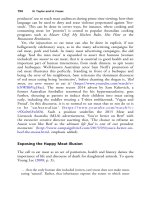The palgrave international handbook of a 210
Bạn đang xem bản rút gọn của tài liệu. Xem và tải ngay bản đầy đủ của tài liệu tại đây (26.44 KB, 1 trang )
Collecting Wildlife
205
deviant attitudes towards animals are ingrained in some aspects of
Western society where masculinities and the social acceptance of male
power influence the extent to which male violence and perspectives on
male dominance are generally accepted as social norms. But excessive use
of violence is criminalised, remaining socially unacceptable and subject to
sanction. However within such societal constructs, certain males will naturally be attracted to activities which emphasise the expression of male power
and male behaviours (Harland et al. 2005; Kimmel et al. 2005). Big game
hunting, for example, sometimes places the hunter at personal risk and
incorporates a range of stereotypical male behaviours relating to aggression,
dominance and the thrill of chasing after an animal in its natural environment where nominally, at least, it should have the upper hand (Nurse
2013a). Contemporary environmental and wildlife protection legislation
has criminalised activities such as egg collecting (illegal in the UK since
1954) and strictly regulates the possession of dead animals, parts and
derivatives via both international legislation such as the Convention on
International Trade in Endangered Species of wild fauna and flora
(CITES) and domestic (national) conservation and animal protection policies. Accordingly, those wishing to continue with such activities engage in
stereotypical male activities via their resistance to control.
Understanding the psychology of offenders, the socio-economic pressures that affect them and the sociological and cultural issues that impact
on behaviour greatly aids understanding of what needs to be done to
address criminal and deviant behaviours (Becker 1963) and the conditions that lead to animal abuse. Previous research (Nurse 2013a) identifies that animal offenders are not a homogenous group and that a range
of offender types and offending behaviour exist in the area of animal
harm. Thus, some animal harm offences are motivated by purely financial considerations, some by economic or employment constraints
(Roberts et al. 2001, p. 27). Others are motivated by predisposition
towards some elements of the activity such as collecting; or exercising
power over animals or the need to control others via the threat of harm
to animals (Nurse 2013a). Via case studies of egg collecting and taxidermy and trophy collection this chapter examines anthropogenic commodification of animal parts and derivates and looks both at the causes
of animal collecting and the nature of collecting as animal abuse. It also
examines some issues concerning the prevalence of collecting activity and
societal and law enforcement responses. But in doing so, notes that
collecting as animal abuse is very much on the fringes of policing animal
abuse and is poorly monitored, although this chapter argues that









